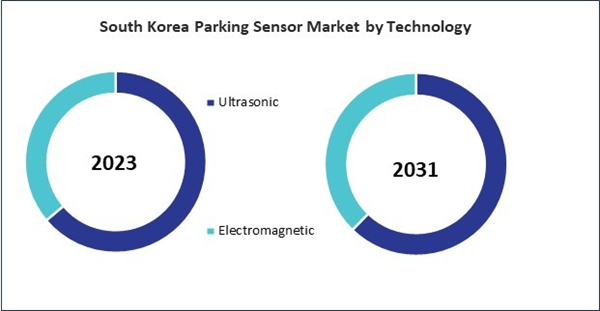The China market dominated the Asia Pacific Parking Sensor Market by Country in 2023, and would continue to be a dominant market till 2031; thereby, achieving a market value of $1.73 billion by 2031. The Japan market is registering a CAGR of 15% during 2024-2031. Additionally, the India market would showcase a CAGR of 16.4% during 2024-2031.
Many automotive manufacturers now include these sensors as standard features in new vehicle models, particularly in mid-range and premium segments. This shift reflects a growing recognition of these sensors as essential safety equipment rather than optional add-ons. In some regions, government regulations and safety standards mandate the inclusion of certain vehicle safety features, such as parking sensors. Additionally, incentives and subsidies for safety technology can boost the adoption of these sensors.
In addition, the increasing preference for technologically advanced vehicles has led to higher adoption rates of these sensors. As consumers demand more tech features, these sensors are becoming popular due to their contribution to a high-tech driving experience. The growing availability of cost-effective aftermarket these sensors has facilitated adoption among vehicle owners who want to upgrade their existing vehicles. This affordability has expanded the market beyond new vehicle buyers.
The rise in automotive industry activities in India often leads to establishing or expanding manufacturing facilities. This encompasses the local manufacturing of these sensors, which can lower costs and enhance supply chain efficiency within the domestic market. As per the Investment Promotion and Facilitation Agency, the nation’s automotive industry is worth more than $222 Bn and contributes 35% to Manufacturing GDP. The automobile industry produced 22.93 Mn vehicles. India holds a strong position in the international heavy vehicles arena as it is the largest tractor manufacturer, second-largest bus manufacturer, and third-largest heavy truck manufacturer in the world. The vehicle production and sales growth in India directly drive the demand for these sensors. The rapid expansion of the vehicle fleet in China leads to a higher demand for parking solutions. As more vehicles are on the road, these sensors become crucial for managing the increased volume of vehicles and alleviating parking challenges. As per the State Council of the People's Republic of China, China's motor vehicle fleet in 2023 had swelled by 116 million units to 440 million, an increase of 36 percent, while the total number of drivers had grown by 112 million, or 27 percent, to 530 million. In conclusion, the rising automotive industry and increasing vehicle fleets in the region drive the market's growth.
List of Key Companies Profiled
- Robert Bosch GmbH
- Aptiv PLC
- Denso Corporation
- Valeo SA
- ZF Friedrichshafen AG
- Continental AG
- NXP Semiconductors N.V.
- Ford Motor Company
- Mercedes-Benz Group AG
- Infineon Technologies AG
Market Report Segmentation
By Technology
- Ultrasonic
- Electromagnetic
By Installation
- OEM
- Aftermarket
By Country
- China
- Japan
- India
- South Korea
- Australia
- Malaysia
- Rest of Asia Pacific
Table of Contents
Companies Mentioned
- Robert Bosch GmbH
- Aptiv PLC
- Denso Corporation
- Valeo SA
- ZF Friedrichshafen AG
- Continental AG
- NXP Semiconductors N.V.
- Ford Motor Company
- Mercedes-Benz Group AG
- Infineon Technologies AG
Methodology

LOADING...









